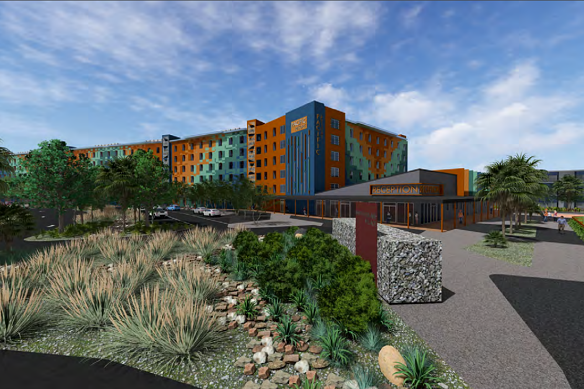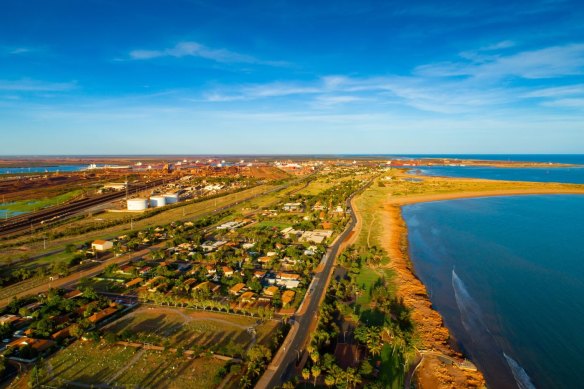Planners shutdown bid for $500m South Hedland FIFO, tourism hub
State planners have rejected a $500 million bid to construct another sprawling accommodation hub for transient workers and tourists in the mining town of South Hedland.
The development application, led by CIMIC subsidiary Pacific Partnerships, comprised more than 1650 rooms, a kitchen and dining area, cafe, tavern and beer garden and recreation and wellness facilities.

The South Hedland development by CIMIC subsidiary Pacific Partnerships comprises more than 1650 rooms.Credit: Pacific Partnerships.
Under the proposal, more than two-thirds of the rooms were set to serve as accommodation for fly-in, fly-out mining, construction and maintenance workers, with the remaining 514 rooms to sit within a six-storey hotel on Parola Crescent.
The mega-hub was earmarked for four amalgamated lots spanning 9.6 hectares on the western fringe of South Hedland’s urban area and less than a kilometre from its town centre, 1600 kilometres north of Perth.
The site is located south-west of Club Hamilton, a mining and service worker accommodation hub run by mining giant Fortescue Metals Group, and sits west of the ESS Gateway Village occupied by staff from Roy Hill and BHP.
Despite the proposal having been recommended for approval against the council’s wishes, the regional development assessment panel ultimately rejected the application during a meeting on Wednesday.
Prominent local business owner Owen Hightower claimed the development appeared as if it hailed from the “Soviet era” and raised concerns about the impact of the population injection on existing road infrastructure.
The developer’s lawyers and consultants fielded several questions about the design, location and impact of traffic and touted the growing demand for workforce accommodation, but the responses were not enough to persuade the panel.
The development was tipped to be the most significant of its kind in the Town of Port Hedland, which is home to the country’s largest bulk export port and known as Australia’s epicentre for iron ore export.
It is estimated up to $90 billion worth of iron ore made its way through the port last financial year, with the commodity representing almost 99 per cent of all exports.
Its progression had hinged on the parties inking a tripartite lease that would see the state lease the land to the town, which would then sublease the land to Pacific Partnerships for the next two decades.
The proposed lease agreement is currently being reviewed by the town’s lawyers, but WAtoday understands the land tenure deal is expected to be finalised in early 2025.
The bid comes just three years after the town endorsed a new planning policy identifying land for development to respond to fluctuations in the economy, population change and the need for diverse housing in the nexus of Australia’s iron-ore industry.

The export hub was deemed to have created 3581 full-time direct and indirect jobs in Port Hedland.Credit: Bloomberg
Forever a FIFO town?
The lucrative salaries for work in the resources-rich region draw in thousands of workers from across the country each fortnight.
Port Hedland has a population of around 16,000, including the satellite town of South Hedland.
But it swells to more than 20,000 when you account for its 5000-strong contingent of fly-in, fly-out workers.
Treasury estimates that more than 70 per cent of the Pilbara’s local economy is reliant on the mining industry, and mining companies spend big on accommodation perks in the battle to attract and retain staff.
Meanwhile, local governments in the region, including the Town of Port Hedland, have been battling to persuade mining operators and workers to permanently relocate to the towns, but with limited success.
A social impact survey penned by consultancy Creating Communities for the Pacific Partnerships project pointed out the “delicate balance” in the proportion of residents and non-residents in the Town of Port Hedland and said it had long-term implications for its housing, liveability, economy, and identity.
If increases to the transient workforce weren’t countered by residential population growth and economic diversification, the survey warned there may be no reversing the reputational impact.
“Without the appropriate measures in place, the Town of Port Hedland risks approaching a ‘tipping point’ at which the town becomes perceived as a FIFO hub rather than an attractive place to live permanently,” it found.
But it also concluded the constrained housing market, coupled with the sky-high cost of materials and labour and the difficulties financing residential construction in the Pilbara, meant the likelihood of increasing the housing supply was low and transient worker accommodation was needed.
Town of Port Hedland Planning and Economic Development manager Chaz Roberts told WAtoday the plan came after it uncovered the lengthy pipeline of industrial expansion projects in the region had not adequately considered the need for accommodation.
The site was selected for its proximity to the town centre and the likelihood of flow-on benefits for South Hedland businesses, which Roberts said were not served by workforce hubs on isolated mining tenements.
But the town hasn’t abandoned its hopes of leveraging the burgeoning industry to grow its residential population.
Town officers have partnered with the Pilbara Development Commission to develop a local housing strategy, with “residential first” listed as the town’s ultimate preference.
Roberts said the town had issued fewer than 40 approvals for residential dwellings in the past two years, well below the 100 dwellings required annually to keep pace with the forecasted residential population growth.
He said the cost of construction in an economy dominated by the resources sector was a key factor, as were the state government’s planning laws.
“The legislative framework for mining and planning that is set by the state government does not allow for a local government to stop workforce accommodation projects altogether,” he said.
“A local government can only influence the location, design standard, social integration and time limit on a planning approval, if the proposal is not located on a mining tenement or part of a State Agreement.
“There needs to be a suitable mix of workforce accommodation and housing to accommodate a growing economy, and the town is working on all fronts to accommodate appropriate sustainable growth using the levers available to local government.
“A collaborative effort is required with governments and industry to ensure the local community’s needs are met in relation to housing in the coming years.”
Get the day’s breaking news, entertainment ideas and a long read to enjoy. Sign up to receive our Evening Edition newsletter.